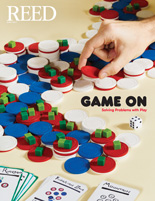
IRIS login | Reed College home Volume 96, No. 2: June 2017
The Joy of Cooking, (with methylcellulose)
If you're a foodie or a viewer of Bravo channel's Top Chef you're familiar with the culinary movement known as molecular gastronomy. This awkward combination of words describes an inventive way of cooking with the use of tools and food products you're not likely to find in the glossary of Irma Rombauer's cookbooks or by watching reruns of The French Chef.
These techniques and tools include mixing sodium alginate into, say, pureed peas and submersing the mixture in a bath of calcium chloride to create pea balls; using liquid nitrogen to freeze linguine into edible sculptures; and centrifuges that turn fruits into crystal clear yet still flavorful liquids.
The giants of this movement--Ferran Adrià, Heston Blumenthal, and Andoni Luis Aduriz--see these techniques as the evolution of the modern kitchen, or in the instance of the Paideia class, Don't Lick the Spoon: Adventures in Edible Chemistry, the modern dorm dining hall. Chemistry majors Galen Miley '13, Ilsa Kirby '13, and Kayla Sheridan '13 used their skills in this area to transport their class to the intersection of Science Drive and Yummy Street.
In the course abstract they promised to challenge our understanding of food and flavor, along with the limits of liquid nitrogen. My favorite item, potato ice cream, delivered on two of those promises. Given 32 flavors, potato ice cream would have landed 32nd on my must-try lists. To my surprise, the treat was a culinary triumph, but the only scientific misstep of the night.
The mixture was supposed to turn stretchy, like a type of Turkish ice cream called dondurma, but never got past delightfully creamy. The starch in the potatoes was intended to act as a replacement for the thickening agent, salep, which is flour made from the root of the Early Purple Orchid. Salep can no longer be sold in the US because the orchid is endangered.
The instructors also lugged out a centrifuge--or as it's known in common kitchen parlance, a salad spinner--to clarify orange and grapefruit juices. They lined the spinner with cheesecloth, added agar, and spun out all the pulp and most of the color, but none of the fruit flavor. This application, I was told, mostly appeals to the aesthetic and is used to create colorless cocktails--something we did not get to sample.
The band of culinary-inclined chemists also set a batch of eggs in a bath of 63 degree water (Celsius) as their class began. As the presentation wrapped up, participants cracked open perfectly poached eggs. The unusual sight of a poached egg sliding from a freshly cracked shell drew a couple of uncertain guttural utterances, which as far as I can tell is part of the appeal of molecular gastronomy--to present the unexpected.
The blueberry foam was an excellent example of gastronomic dissonance. The foam is created by adding methylcellulose F50 (a wood product in powdered form) to pureed berries. The resulting foam looked more like a bath product than food. The foam is light and creates greater surface area on your tongue, causing the flavor to explode. It seemed to intensify the taste, but I'm told that sensation was created totally by the texture.
The instructors were very knowledgeable about their topic, and their presentation was entertaining, informative, and delicious. As far as molecular gastronomy, like every avant garde movement it will continue to struggle for acceptance within the dominant community. But it seems clear that many of its techniques will be adopted as the technology becomes more readily available in standard kitchens--or college dinning halls.
Tags: fruit foam, molecular gastronomy, Paideia, potato ice cream




LATEST COMMENTS
steve-jobs-1976 I knew Steve Jobs when he was on the second floor of Quincy. (Fall...
Utnapishtim - 2 weeks ago
Prof. Mason Drukman [political science 1964–70] This is gold, pure gold. God bless, Prof. Drukman.
puredog - 1 month ago
virginia-davis-1965 Such a good friend & compatriot in the day of Satyricon...
czarchasm - 4 months ago
John Peara Baba 1990 John died of a broken heart from losing his mom and then his...
kodachrome - 7 months ago
Carol Sawyer 1962 Who wrote this obit? I'm writing something about Carol Sawyer...
MsLaurie Pepper - 8 months ago
William W. Wissman MAT 1969 ...and THREE sisters. Sabra, the oldest, Mary, the middle, and...
riclf - 10 months ago